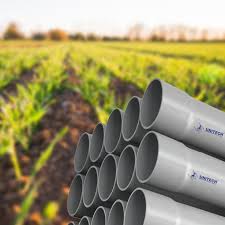Agriculture Pipes & Fittings

Agriculture pipes and fittings are essential components for irrigation, water supply, drainage, and other applications in farming. Selecting the right type and quality is crucial for efficient and long-lasting agricultural systems.
Common Types of Agriculture Pipes:
You’ll find several types of pipes used in agriculture, each with its own advantages and applications:
- PVC (Polyvinyl Chloride) Pipes:
- PVC-U (Unplasticized PVC): Rigid and commonly used for water supply, irrigation, and drainage. They are cost-effective, lightweight, and resistant to corrosion and chemicals. You’ll find different pressure ratings (like Class 1, 2, 3, etc. or PN values) depending on the application.
- PVC-O (Molecularly Oriented PVC): Stronger and more flexible than PVC-U, often used for higher-pressure irrigation systems and water distribution.
- PVC Flexible Garden Pipes: Used for general watering and low-pressure applications in gardens and farms.
- HDPE (High-Density Polyethylene) Pipes: Known for their flexibility, lightweight nature, and resistance to chemicals and UV rays. They are often used in drip irrigation, sprinkler systems, and water supply lines, especially for longer distances and uneven terrain. They can be joined using heat fusion, compression fittings, or barbed fittings.
- LDPE (Low-Density Polyethylene) Pipes: More flexible than HDPE and commonly used for drip irrigation laterals and low-pressure applications in smaller farms and nurseries. They are typically connected using barbed fittings.
- MDPE (Medium-Density Polyethylene) Pipes: Offers a balance between flexibility and strength, used for various irrigation and water supply purposes.
- Galvanized Steel Pipes: While less common now due to corrosion issues and higher cost compared to plastics, they are still used in some older or specific high-pressure applications.
- Copper Pipes: Historically used, but now less common in general agriculture due to cost and installation complexity. They offer good flow rates.
- Corrugated Pipes: Used primarily for drainage and managing excess water in fields. They can be made of HDPE or PVC.
- Suction Hose Pipes: Flexible pipes used to draw water from sources like ponds or wells into pumps.
Common Types of Agriculture Fittings:
Fittings are used to connect pipes, change direction, control flow, and connect to various irrigation components. Common types include:
- Couplers/Joiners: To connect two pipes of the same diameter. These can be solvent weld (for PVC), barbed or compression (for PE), threaded (for some rigid pipes), or ring-lock types.
- Elbows (90 and 45 degrees): To change the direction of the pipe run. Available in various materials and connection types.
- Tees: To create a branch in the pipeline, allowing water to flow in three directions. Can be equal or reducing (different outlet sizes).
- Reducers: To connect pipes of different diameters.
- End Caps: To close the end of a pipe.
- Valves: To control the flow of water. Common types include ball valves, gate valves, and check valves.
- Clamps and Saddles: To secure pipes or tap into existing lines.
- Drip Emitter Connectors: Specialized fittings to connect drip lines and emitters to main or sub-main pipes. These can be barbed, threaded, or lock-ring types.
- Sprinkler Risers and Adaptors: Fittings to connect sprinklers to the main irrigation lines.
- Filters: To remove debris and prevent clogging in irrigation systems.
- Fertilizer Injector Fittings (Venturi): To introduce fertilizers or other chemicals into the irrigation water.